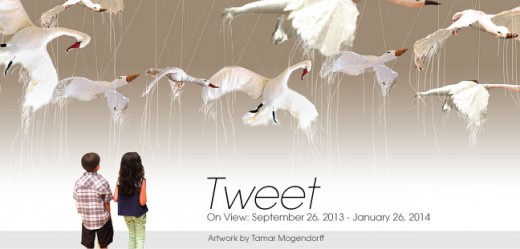There’s still room to join The Teaching Project, taught by Fine Arts faculty member Shane Aslan Seltzer. This is a 3-credit, project-based course that looks at progressive early childhood education approaches as a means for activating our studio processes through observational and material research. The class will primarily investigate the Children’s Museum of Art (CMA) as a site for innovative contemporary production centered around children, including projects which will integrate the Tweet Exhibition at CMT. Parsons Students will coproduce new works under the title, Tweeting: The Bird Show, an interview series conducted with CMA staff and visitors representing their “bird-selves.”
Exploring social media platforms such as Instagram and Twitter, Parsons students will also create their own hashtag “bird watching” projects online, adding another participatory layer to the Tweet exhibition.
The class is open to all School of Art, Media & Technology upper-level undergraduate degree students. Find out more about the course here: PSAM 3710 – Collaborative Research Studio: The Teaching Project – Early Imagination, and more about the instructor and her thoughts on the class, children’s arts education and Twitter below!

AMT: To start, Shane, what brought you to CMA in the first place?
SHANE ASLAN SELZER: CMA has a wonderful new Director Barbara Hunt McLanahan, who knows Anthony Aziz (BFA Director AMT). She reached out through Facebook about starting new partnerships and Anthony thought this would be exciting for Parsons to get involved with. He brought myself and Anthony Whitfield (Social Engagement Director ADHT) into conversation with CMA’s staff. After initial meetings, we held a roundtable brainstorming session that included six Parsons faculty and six CMA staff members. My class is the first incarnation of this partnership, but the hope is that it will grow in a variety of ways in the coming years.
AMT: Has working with children aways been part of your arts practice?
SAS: My mother is a leader in progressive early childhood development. Early on, I was exposed to child centered learning that emphasized my own perspective, imagination, observation and hands on learning. My graduate thesis was about how many studio based art practices are closely aligned with object relations theory (D.W. Winnicott) and project based learning strategies (Reggio Emilia).
AMT: What fascinates you most about Twitter?
SAS: I’m thinking about Twitter as a form of poetry. The limit of 140 characters or less asks you to make very clear decisions about how you write. It’s evolving into a new pattern for human manipulation.
AMT: Who should take this class and why?
SAS: People who want to understand how project based work happens within the context of large institutions should definitely take this class. It will help you shape your ideas to work with specific audiences and focused interactions. You will learn about project proposals, development, execution and assessment. People who are intrigued by modes of communication and who want to explore collaboration and co-production will gain valuable skills in this class. People who find children an inspiration for ideas and processes will have lots of fun in this class.
AMT: What outcomes are you hoping to achieve with this class?
SAS: We are going to pitch, develop and execute new works that will be included in CMA’s fall exhibition. We are going to better understand the unique culture of CMA and how artists can collaborate with them on programming.
AMT: What do hashtags mean to you?
SAS: Hashtags create social archives by using keywords to tag posts (this includes images, links and text). No one has really agreed on what any given hashtag means, so the archive provides a range of interpretations. For example #birdwatching has a lot of images of birds, cats, and golfers, but it also has a good amount of landscapes with no subject. What we will do with these archives has yet to unfold, we use them to increase the number of people who may see our posts, but we also use them to categorize our posts for future reference.